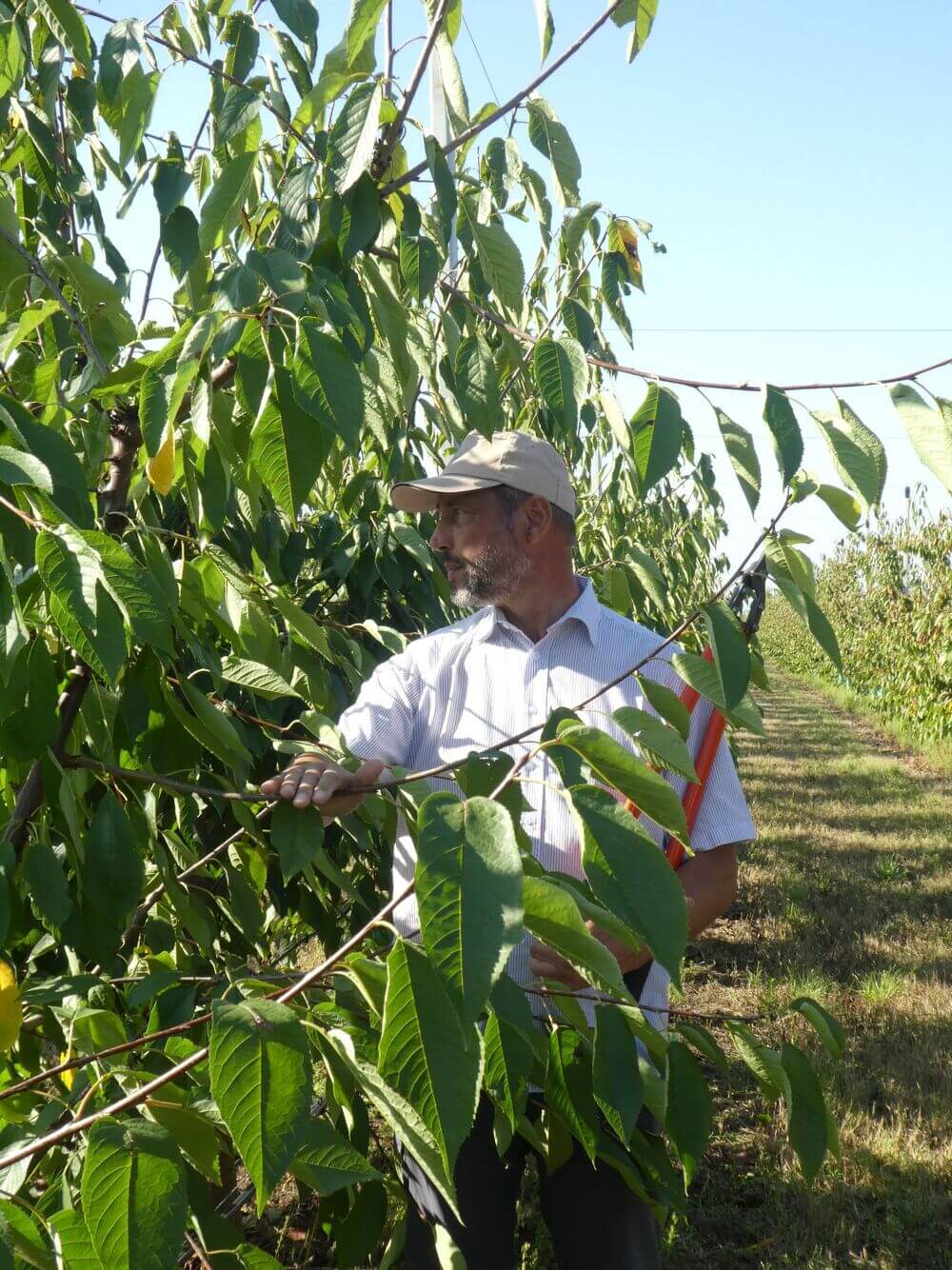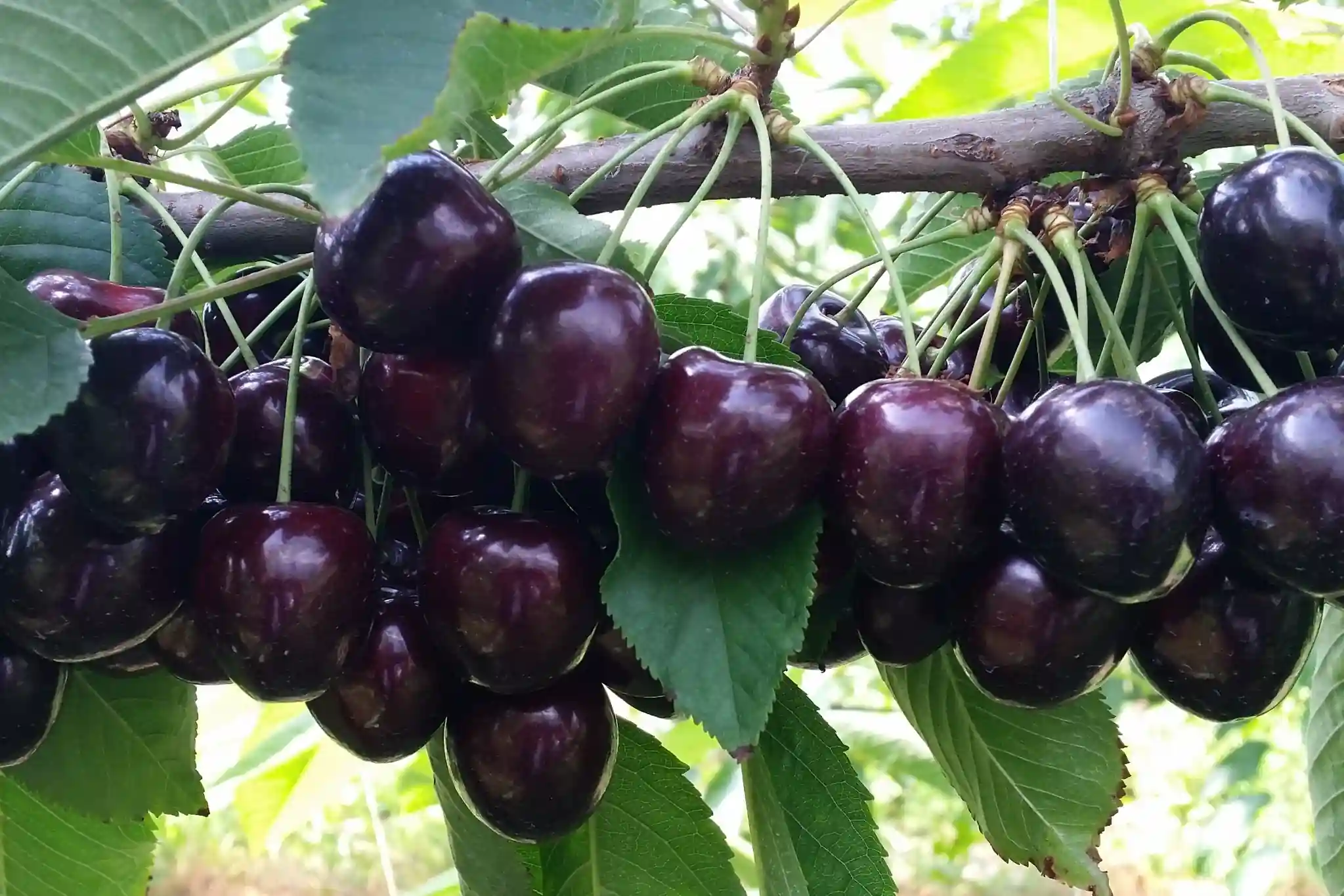Pruning demonstration of an intensive sweet cherry orchard was held in September by Peter Hilsendegen, the director of Oppenheim Research Center of Fruit Growing in Agárd, due to the organization of Tész-Ész Nonprofit Kft. The main topic of the appointment was the changing of fruiting wood on 4 year old slender spindle trees. The lecture of Peter Hilsendegen was translated precisely by Enikő Báderné Barakonyi.
Péter Fülöp is the owner of the orchard of 10 hectares, containing varieties Sweet Early, Sweet Aryana, Sweet Gabriel, Kordia, Regina and Grace Star at 4 x 2,5 m spacing on Gisela 6 and Maxma 14 rootstocks. The varieties were chosen by Péter Kelemen. The trees from Italian import were planted in 2019/2020 winter
The terroir is not frosty, e.g. 3 degree below zero occurred only twice this year. However, the lack of precipitation is characteristic as rain can arrive only from one direction as the other directions are blocked by Danube River, Lake Velence and the Vál-valley. The yield was 5-7 kg/tree this year and the harvested fruits were sold directly to traders from the orchard in little wooden boxes of 5 kg.
The purpose is to reach 10 kg/tree yield and that will be possible in the next year according to Péter Fülöp. The fruits are not selected and sold uniformly in 28+ category. The owner does not want to produce fruits far over this size. The water is supplemented by drip irrigation from own source and fertilization is also applied.
 Image 1: Pruning should be start at the top of the tree.
Image 1: Pruning should be start at the top of the tree.
Final height
The most important factor of training spindle trees is to maintain the dominance of the central leader. The cultivars in the orchard can be classified to 3 groups according to their vigour:
- Regina e Sweet Lorenz
- Kordia e Sweet Aryana
- Grace Star
The ceiling of the orchard (anti hail net or anti rain foil) is not ready yet but the support system indicates the planned height. As the height is not possible to limit yet, let the trees grow provisionally over the height of the planned ceiling is good solution.
The central leaders can be cut back in the future after the formation of fruiting branches under the terminal part of the leaders. These fruiting branches can diminish the growth response to the cutting back of the axis in the fourth or fifth year. Until this point the trees are trained without removing the terminal buds of the central leaders.
 Image 2: The top of the tree after pruning.
Image 2: The top of the tree after pruning.
 Image 3: Enik++ª Barakonyi - The well pruned slender spindle is conical.
Image 3: Enik++ª Barakonyi - The well pruned slender spindle is conical.
Long spurs are needed
The fruiting woods (1-3 years old elements of the canopy) are permanently changed on the axis and on the basic permanent branches of slender spindle trees. The goal is to hold the most valuable young fruiting wood close to the axis and the basal branches. In the case of proper pruning the spindle form lets the sunshine inside the canopy, and we can avoid the dying of the inner wooden parts in the lower region of the canopy.
The most vigorous parts of the canopy must be removed to keep the growth balance of the tree and to avoid the shadowing of the lower branches. Kordia is especially sensitive to the lack of light.
In optimal case there are similar numbers of one year old shoots and 2 years old branches on the axis in the middle of the canopy. The young shoots must be thinned out appropriately and cut back to leave long spurs. The strong cutting back to short spurs in not applicable in the case of sour cherry because of the danger of wilting. The optimum size is 20 to 30 cm, shorter spurs are only applied in the upper part of the tree.
The excessively strong 2 years old branches must be removed. This category means branches with basal diameter exceeding the half of the central leader. The best possibility is to cut back these branches to healthy one year old shoots not far from the axis.
This cutting back is to be repeated in the next year and finally the unnecessary branch can be fully removed. While we cut back a strong branch step by step hopefully new growth may appear close to the branch and later will supplement it. If we can find good weaker elements this slow process is not needed and the unwanted branch can be removed immediately
Cultivars like Regina feature upright shoots. The shoots of these varieties can be trained without cutting back. Later the weight of the fruits will spread the shoots. Regina is especially sensitive to pruning: the shoots can lose fruits after cutting back.
 Image 4: Peter Hilsendegen - The optimal shoot growth is 50-60 cm.
Image 4: Peter Hilsendegen - The optimal shoot growth is 50-60 cm.
The importance of warmth
The normal date of the demonstrated pruning method is the end of August or the beginning of September. However, this year it is to be done until the beginning of October due to the favourable weather. The warm and dry weather is important after the pruning to suit good conditions for the healing of the cut surfaces. In the case of 2-3 warm days with 12-15 °C other treatment like disinfectant spraying is not needed.
The closing of the terminal buds is also important condition of the pruning to prevent the initiation of new growth. The regulation of growth can also be done earlier by hand removing of too strong or unwanted shoots in July. The most valuable shoots are the medium (50-60 cm) long ones while the longer shoots need pruning back.
 Image 5: Sometimes is better to regrow the tree.
Image 5: Sometimes is better to regrow the tree.
Weak or strong growth
Kordia has slagging shoots in older years and the shoots are sensitive to the lack of sunshine so that this cultivar needs different pruning treatments than Regina. We have to take care of this feature during the training of young Kordia trees. The upright shoots can be trained without cutting back while the upper part (one third) of the lateral shoots must be removed.
The fruiting branches in the canopy also need regular pruning. The varieties of this kind need more work hours during pruning. The shoots developing in the middle of the canopy also need cutting back. The very strong upright branches can be removed if we can find weaker shoots near them.
Grace Star has strong vigour. As self-fertile variety needs extra care to avoid overproduction resulting in weak growth in the next year. The long shoots full of flower buds need cutting back to reduce the number of fruits.
The fruiting branches on the central leader also need pruning back to one year old shoots. The long spurs will die after the harvest but new shoots may appear. The non bearing elements inside the canopy must be removed to improve light penetration.
The slender spindle trees have to be trained with 3 to 6 basal (scaffold) branches. The more basal branches are useful in very productive varieties like Grace Star. This variety has also inclination for the softening of the fruit so the appropriate harvest time is important as to Peter Hilsendegen.
Sourcee: Hungarian weekly magazine Kertészet és Szőlészet
Csilla Horváth
Cherry Times - All rights reserved















